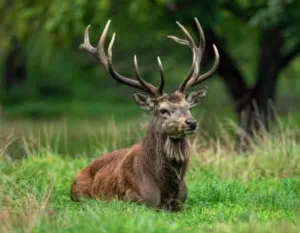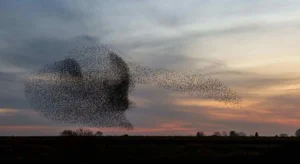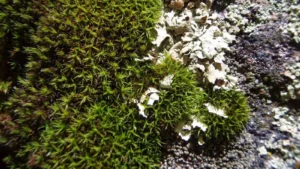Exploring the Secret Season – Wildlife, Fungi, and Forest Discoveries for Curious Families
When autumn fades and winter waits on the horizon, nature enters one of its most mysterious months. Nature in November may seem quiet at first glance, but in woodlands, fields, and gardens, life is busier than ever. Animals prepare for winter, birds migrate, and underground, fungi connect forests through unseen networks.
This is a wonderful month for family walks, classroom learning, and mindful discovery – a time to notice the transformations happening all around us.
Woodland Wildlife – Preparing for the Cold
Hedgehogs
By November, most hedgehogs are searching for safe hibernation sites. They build winter nests called hibernacula using dry leaves, moss, and grass — often tucked under sheds, log piles, or compost heaps. Once temperatures drop below about 10°C, they enter deep sleep, lowering their heart rate from 190 beats per minute to around 20!
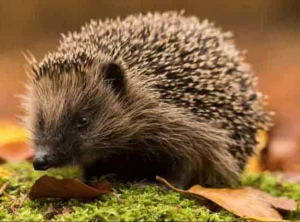
🦔 Help them at home:
Leave a corner of your garden wild with piles of leaves and logs. This creates a safe space for hedgehogs to nest, forage and hibernate. A small, untidy patch can be a lifeline during colder months, offering warmth, food and shelter from predators.
Avoid lighting bonfires without checking for hidden hedgehogs. Stacked wood and dry leaves make perfect hiding spots, so always rebuild your bonfire on the day you light it. Use a torch and gently move logs to be sure no animals are inside.
If you see a hedgehog out in daylight in November, it could be in trouble. Healthy hedgehogs are usually nocturnal, so daytime wandering can mean it’s underweight or ill. Place it somewhere safe and warm in a box with a towel and shallow water, and contact your local wildlife rescue or the British Hedgehog Preservation Society for advice.
Foxes
Foxes don’t hibernate, but November is when they start pairing up for the breeding season ahead. You might hear their haunting, high-pitched calls echoing through the night. Urban foxes are especially active, scavenging for food and teaching their cubs how to survive the winter.
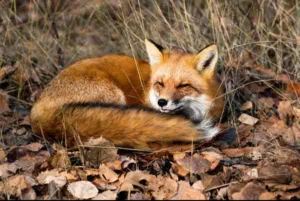
🦊 Did you know?
Foxes communicate through scent trails and up to 28 different vocal sounds — a real example of how complex animal “languages” can be. Some scientists studying fox communication have used it to inspire research into non-verbal AI signals and sound recognition — another case of biomimicry in action.
Deer
In November, the deer rut is coming to an end. For weeks, males have been clashing antlers, roaring, and chasing rivals in fierce displays of strength to win over females. By now, their energy reserves are low and injuries are common, so the stags retreat to quieter areas to rest and feed.
You’ll often see small groups of deer grazing peacefully in open fields or along woodland edges, rebuilding their strength after the intensity of the rut. Their coats have thickened for winter, helping them blend into the fading autumn landscape.
Females, having mated, now focus on feeding to prepare for the cold months ahead and the energy demands of carrying next year’s young. The woodlands feel calmer, but if you listen closely, you may still hear the last faint echoes of a distant roar.
Wild Boar
Wild boar, once extinct in Britain but now returning to parts of the Forest of Dean and Kent, are snuffling through the leaf litter in family groups known as sounders. Their powerful snouts turn over the soil, helping aerate the ground and mix nutrients — a natural form of ploughing that benefits woodland ecosystems.
🐗 Nature’s engineers
The way wild boar churn soil has inspired soil restoration projects and “rewilding” research — showing how the behaviour of one species can guide human farming and conservation design.
The Hidden World of Fungi
The Wood Wide Web
November is peak season for fungi. Beneath your feet lies a vast living network of mycelium — the underground “roots” of mushrooms. This network connects trees and plants in a vast communication web, helping them share water, minerals, and warning signals.
It’s as if the forest has its own internet. Electrical pulses travel through mycelial threads at speeds similar to nerve impulses. Some fungi even exchange information in coded bursts — a discovery that has inspired new models for computer networks and sustainable architecture.
What to Look For
- Fly Agaric: The famous red-and-white toadstool, toxic but beautiful.
- Oyster Mushrooms: Found on fallen logs, excellent decomposers.
- Wood Blewits: Violet-hued and hidden under leaves.
- Shaggy Inkcaps: Transform their caps into black “ink” as they release spores — one of nature’s most dramatic disappearing acts.
🌿 Forage wisely:
Always forage with a guide or expert, and never pick mushrooms you can’t identify. Many fungi are vital for soil health and wildlife — leave plenty untouched for nature.
Birds on the Move
November skies are full of movement and song.
Winter Arrivals
Thousands of birds migrate to the UK from colder regions. Look and listen for:
- Redwings and Fieldfares: Arriving from Scandinavia, feeding on hawthorn berries.
- Whooper Swans and Pink-footed Geese: Travelling from Iceland to wetlands like Martin Mere and the Norfolk coast.
- Starlings: Gathering in vast flocks at dusk to perform breathtaking murmurations — swirling, shifting shapes that protect them from predators.
Biomimicry in Flight
Scientists studying murmurations have discovered that each bird responds to the movements of its seven closest neighbours, creating a perfect balance between order and chaos. This same principle has been applied to drone swarm technology and crowd movement design — a perfect example of how nature’s systems inspire human invention.
Insects and the Miniature World
Even though it feels cold, many insects are still active.
- Bees and Butterflies: The last bumblebees can be seen foraging on ivy flowers. Butterflies like the Brimstone and Peacock hide in sheds or hollow trees, waiting for spring.
- Spiders: Still spinning webs to catch late-season flies — their silk is so strong and light it has inspired materials research for flexible body armour and biodegradable plastics.
- Earthworms and Beetles: Burrowing deep into the soil, keeping the ground fertile and full of air.
🐝 Biomimicry note:
Honeybee wing structures inspired designs for efficient drone rotors, while their communication “waggle dance” influenced robotic navigation systems.
The Forest Floor – Seeds, Spores, and Sleep
November is the forest’s recycling month. Leaves rot down, mushrooms spread spores, and seeds prepare for dormancy. The forest may seem asleep, but underground, it’s alive with transformation.
- Trees draw nutrients back from their leaves before they fall, storing energy for spring.
- Seeds like those of the sycamore helicopter gently to the ground, perfectly shaped for flight.
- Mosses and lichens soak up water and provide winter homes for tiny creatures.
🌱 Try this: Take a magnifying glass on a woodland walk and look closely at mosses, seed pods, and mushrooms. You’ll discover an entire hidden city of life.
By the Water – Ducks, Frogs, and Herons

- Mallards and Teal dabble in calm waters.
- Herons stand motionless, hunting patiently.
- Frogs and Newts begin settling into the mud at the pond bottom to hibernate.
💧 Amazing adaptation
Some amphibians produce antifreeze-like chemicals that stop their cells from freezing completely — nature’s answer to cryogenics!
Stargazing and Quiet Nights
With longer nights and crisp, clear air, November is ideal for stargazing. Look for the constellations Orion, Taurus, and the Pleiades cluster sometimes called the Seven Sisters. Shooting stars from the Leonid meteor shower often streak across the sky this month.
For families:
- Wrap up warm and head to a dark-sky area.
- Use a free app like SkyView to identify stars and planets.
- Listen to calming music or an audiobook under the stars — Lost on Infinity is perfect for quiet nights, combining story, song, and natural wonder.
Helping Nature in November
- Leave a Wild Patch: Don’t tidy everything away – fallen leaves make homes for insects and small mammals.
- Feed the Birds: Add suet, seeds, and clean water to your garden feeders.
- Avoid Pesticides: Many insects overwinter as larvae or eggs in soil and leaf piles.
Small actions at home can make a huge difference to local ecosystems – a great message for children learning about sustainability and empathy for living things.
Fireworks and Wildlife Care
Fireworks season can frighten animals. Keep pets indoors and check gardens before lighting bonfires. Hedgehogs, toads, and even nesting birds sometimes shelter inside unlit piles of wood.
Creating a “quiet den” for your cat or dog with blankets and soothing sounds can help them feel safe. You can read more tips on the PSDA website.
🍁🍂🎃🍁🍂🎃🍁🍂🎃🍁🍂🎃🍁🍂🎃🍁🍂🎃🍁🍂🎃🍁🍂🎃
For children who love animals:
At Rockford’s Rock Opera, we believe nature’s resilience can inspire both science and imagination. Our story Lost on Infinity explores extinction, biomimicry, and the secrets of the natural world through an unforgettable musical adventure.
Explore our world today:
Get the Lost on Infinity illustrated book with free musical audiobook – a totally immersive experience.
Listen to the first part of the Lost on Infinity audiobook and watch the animated adventure free on Apple App Store and Google Play.
Download our FREE lesson plans and slides about Extinction and Biomimicry. We also have a selection of classroom activities on our website.
For even more exploration of the natural world, tune in to our Stories, Science & Secrets podcast for kids. Join Matthew, Elaine, Steve Punt and special guests, as we delve into the fascinating world of biomimicry and the inspiring ways science learns from nature’s genius.


